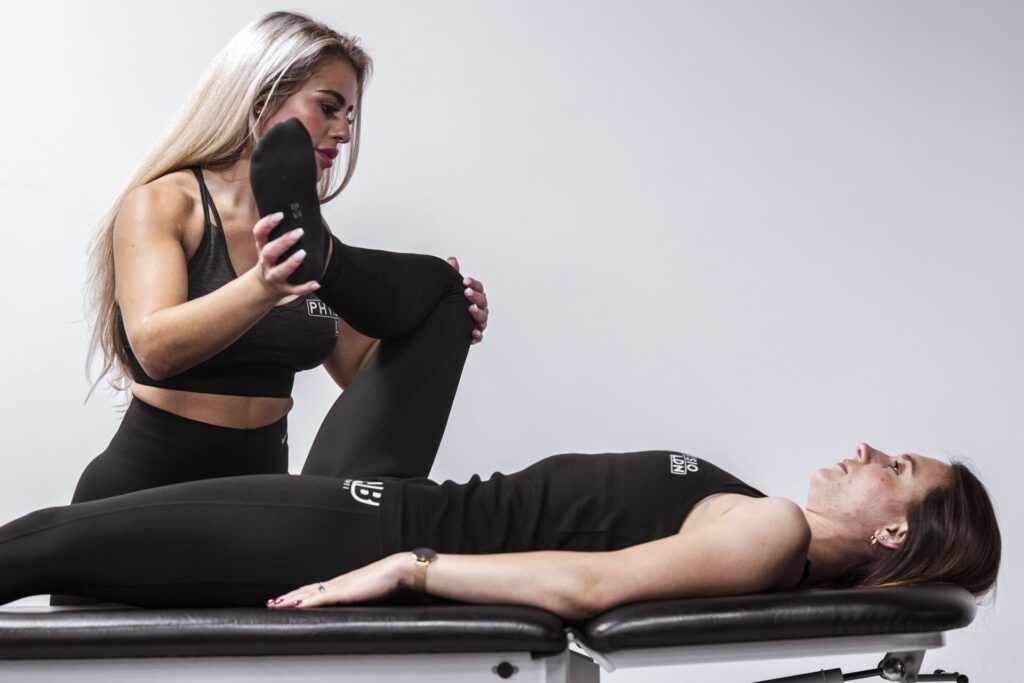Table of Contents
Main Takeaways
- Knee “giving way” is usually due to ligament/meniscus injury, patellar instability, muscle weakness, or osteoarthritis (pain, swelling, altered mechanics).
- Good diagnosis = mechanism of episodes, instability tests (Lachman, pivot shift, patellar tracking), and selective imaging (X-ray/MRI) when indicated.
- First-line care: physiotherapy (strength, balance, proprioception), activity modification, bracing/taping; RICE for acute flares.
- Lifestyle tweaks—graded loading, supportive footwear, weight management, and fall-prevention habits—reduce recurrence.
- Escalate to injections or surgery (e.g., ligament reconstruction) only for structural tears, recurrent patellar dislocation, or failed conservative care.
Knee pain that causes the joint to give way can be a distressing and debilitating experience. For many, it signals underlying instability that affects daily activities, work productivity, and overall quality of life. In fact, nearly 60% of patients endure knee pain for more than five years, with 30% suffering for a decade or longer, highlighting the chronic nature of this condition and the urgent need for effective management strategies (PR Newswire).For local care options, consider knee pain treatment in London.
Understanding why knees give way, the causes behind instability, and the best treatment and exercise options is crucial for anyone facing this issue. This comprehensive guide explores these aspects with insights from recent research and expert physiotherapy approaches available in London.
Causes of Unstable Knees
Knee instability, often described as the knee “giving way,” can stem from a variety of causes. One of the most common is osteoarthritis, a degenerative joint disease that affects the cartilage and underlying bone. Contrary to popular belief, osteoarthritis is not an inevitable part of aging; many factors such as injury, weight, and activity levels influence its development.
Injuries to ligaments, such as the anterior cruciate ligament, meniscus tears, or muscle weakness around the knee joint, also contribute significantly to instability. These injuries can disrupt the normal biomechanics of the knee, leading to episodes where the joint feels unstable or gives way unexpectedly.
Additionally, chronic conditions like arthritis can cause pain and swelling that impair muscle function and joint stability. This can have a profound impact on daily life and work productivity, as highlighted by a 2023 study emphasizing the socioeconomic burden of knee pain.
Another significant contributor to knee instability is patellar instability, which occurs when the kneecap (patella) dislocates or moves out of its normal position. This condition can arise from anatomical factors, such as a shallow groove in the thigh bone where the patella sits, or from acute injuries during sports activities. Individuals who experience recurrent dislocations may find themselves avoiding certain movements or sports altogether, leading to a decrease in physical activity and further weakening of the muscles that support the knee.
Moreover, conditions like rheumatoid arthritis, which is characterized by inflammation of the joints, can also lead to knee instability. The inflammation can weaken the ligaments and tendons surrounding the knee, making it more susceptible to injury. In some cases, individuals may not even realize that their knee instability is linked to an underlying autoimmune condition, highlighting the importance of comprehensive medical evaluations for those experiencing knee issues.
Treatment Options
Treating knee instability involves a multi-faceted approach tailored to the underlying cause. Physiotherapy plays a central role in managing knee pain and instability by addressing muscle strength, joint mobility, and pain relief. Booking with a professional knee pain physiotherapist ensures your plan is individualized and progression-based.
London’s leading physiotherapy clinics, such as One Body LDN, offer expert assessments and bespoke treatment plans that combine hands-on therapy with exercise rehabilitation to restore function and reduce pain. These clinics often utilize advanced techniques such as dry needling, ultrasound therapy, and electrical stimulation, which can further enhance recovery by promoting blood flow and reducing inflammation.

Recent research underlines the importance of movement as an essential part of osteoarthritis treatment plans. While exercise may improve pain and function in knee arthritis, the clinical significance of these benefits can vary, making personalized therapy crucial. Tailored exercise programs, often developed in conjunction with physiotherapists, can include low-impact activities such as swimming or cycling, which are easier on the joints while still promoting strength and flexibility. This individualized approach not only helps in managing symptoms but also empowers patients by involving them in their own recovery process.
For acute injuries, immediate care may include rest, ice, compression, and elevation (RICE), followed by physiotherapy to regain strength and stability. In some cases, surgical intervention might be necessary, especially for ligament tears or severe cartilage damage. Post-operative rehabilitation is vital to ensure safe recovery and return to activity.
Rehabilitation protocols often emphasize gradual progression, starting with gentle range-of-motion exercises before advancing to more challenging strength and stability drills, ensuring that the knee can withstand the demands of daily activities and sports. For detail information see the blog knee pain relief exercises: strengthen & soothe joints .
Moreover, the knee pain management market is expanding rapidly, with new technologies and therapies emerging to provide more effective solutions for sufferers (MarkWide Research). Innovations such as regenerative medicine, including platelet-rich plasma (PRP) injections and stem cell therapy, are gaining traction as potential game-changers in treating knee conditions.
These therapies aim to harness the body’s natural healing processes, potentially offering long-term relief without the need for invasive procedures. Additionally, wearable technology is becoming increasingly popular, allowing patients to track their activity levels and pain patterns, which can inform treatment adjustments and enhance overall management strategies.
Exercises for Stability
Exercise is a cornerstone in improving knee stability and preventing further episodes of giving way. Strengthening the muscles around the knee, particularly the quadriceps, hamstrings, and calf muscles, helps support the joint and improve control during movement. Engaging in resistance training, such as squats, leg presses, and lunges, can significantly enhance muscle strength, providing a robust framework that stabilizes the knee during dynamic activities.
Additionally, incorporating exercises that focus on the hip and core muscles can further contribute to overall lower body stability, as these areas play a crucial role in maintaining proper alignment and reducing undue stress on the knee joint.

Balance and proprioception exercises are equally important. These exercises train the body to sense joint position and react appropriately, reducing the risk of falls or sudden instability. Simple activities like standing on one leg or using balance boards can be highly effective. More advanced techniques, such as performing single-leg deadlifts or practicing yoga poses like the tree pose, can challenge balance and enhance coordination.
Furthermore, integrating dynamic movements, such as lateral hops or agility drills, can improve the body’s ability to respond to unexpected shifts in weight, which is particularly beneficial for athletes or those engaged in sports.
Physiotherapists in London recommend tailored exercise programs that consider individual needs, injury history, and lifestyle. Such programs often include a mix of strengthening, stretching, and functional training to restore confidence and mobility. These personalized plans may also incorporate the use of resistance bands or stability balls to add variety and challenge to the workouts. Regular assessments and adjustments to the program ensure that progress is monitored and that the exercises remain effective as the individual’s strength and stability improve. These services are delivered by specialist London knee pain physiotherapists.
Despite the benefits, a 2024 study cautions that while exercise improves pain and function in knee arthritis, the clinical importance of these improvements may be uncertain, underscoring the need for comprehensive treatment plans that combine exercise with other therapies. This highlights the importance of not only focusing on physical activity but also considering modalities such as physical therapy, medication, and lifestyle modifications.
Engaging in a holistic approach can lead to more significant improvements in quality of life and overall knee health, allowing individuals to participate more fully in their daily activities and enjoy a more active lifestyle.
FAQ
What causes my knee to give way suddenly?
Knee giving way can be caused by ligament injuries, meniscal tears, muscle weakness, or chronic conditions like osteoarthritis. These issues affect the stability and function of the knee joint, leading to episodes of instability. Additionally, factors such as previous injuries, improper biomechanics, or even certain medications that affect muscle control can contribute to this sudden loss of stability. Understanding the underlying causes is essential for effective treatment and rehabilitation.
How long does knee pain from instability usually last?
Many patients live with knee pain for extended periods; nearly 60% experience pain for over five years, and 30% for ten years or more (PR News Wire). The duration of knee pain can also be influenced by factors such as the severity of the underlying condition, adherence to treatment protocols, and lifestyle choices, including weight management and activity levels. Chronic knee pain can significantly impact daily life, making it crucial for individuals to seek timely intervention and support.
Can exercise help with knee instability?
Yes, exercise is essential for improving knee stability by strengthening muscles and enhancing joint control. However, the benefits may vary, and a personalized approach is recommended (Cochrane Library via US News). A well-structured exercise program can include strength training, flexibility exercises, and balance training, all of which contribute to better joint function. It is important to work with a qualified professional to ensure that exercises are performed correctly and safely, minimizing the risk of further injury while maximizing benefits.
When should I see a physiotherapist for knee pain?
If you experience persistent knee pain, instability, or episodes of giving way, it is advisable to consult a physiotherapist early. Expert assessment can identify the root cause and provide a tailored treatment plan to prevent worsening symptoms. Physiotherapists can also educate patients on proper movement patterns and techniques to avoid aggravating the knee, as well as guide them through rehabilitation exercises that promote healing and restore function.
Are there effective treatments available in London for knee instability?
London offers top-tier physiotherapy services with highly trained clinicians who provide comprehensive assessments and bespoke rehabilitation programs. Clinics like One Body LDN are renowned for their expertise in musculoskeletal conditions and sports injuries. In addition to physiotherapy, patients may also have access to advanced treatment options such as acupuncture, hydrotherapy, and even innovative technologies like shockwave therapy, which can all aid in recovery and enhance knee stability.
Is knee instability related to aging?
While aging can increase the risk of conditions like osteoarthritis, knee instability is not an inevitable consequence of getting older. Many factors are controllable through lifestyle, exercise, and appropriate treatment (The Economic Times). Engaging in regular physical activity, maintaining a healthy weight, and practicing good joint care can significantly mitigate the risks associated with aging. Furthermore, staying informed about knee health and seeking early intervention for any issues can lead to better long-term outcomes, allowing individuals to remain active and engaged in their favorite activities well into their later years.
Take Control of Your Knee Stability with One Body LDN
If knee instability is impacting your life, it’s time to take action with One Body LDN, voted as the best London physio clinic by thousands. Our award-winning team of physiotherapy experts is adept at diagnosing and treating a wide range of conditions, from sports injuries to post-operative care. At One Body LDN, we’re dedicated to fixing the root cause of your knee pain, ensuring that your symptoms don’t become a long-term burden. With a results-based approach, we promise never to oversell treatments, focusing instead on instant pain relief and effective rehabilitation. Our clinicians’ extensive experience, including former athletes and NHS specialists, allows us to provide personalized care that caters to everyone, from corporate office workers to elite athletes. Don’t let knee pain hold you back any longer. Book your free initial assessment at our clinic today and start your journey to a stable, pain-free knee.

